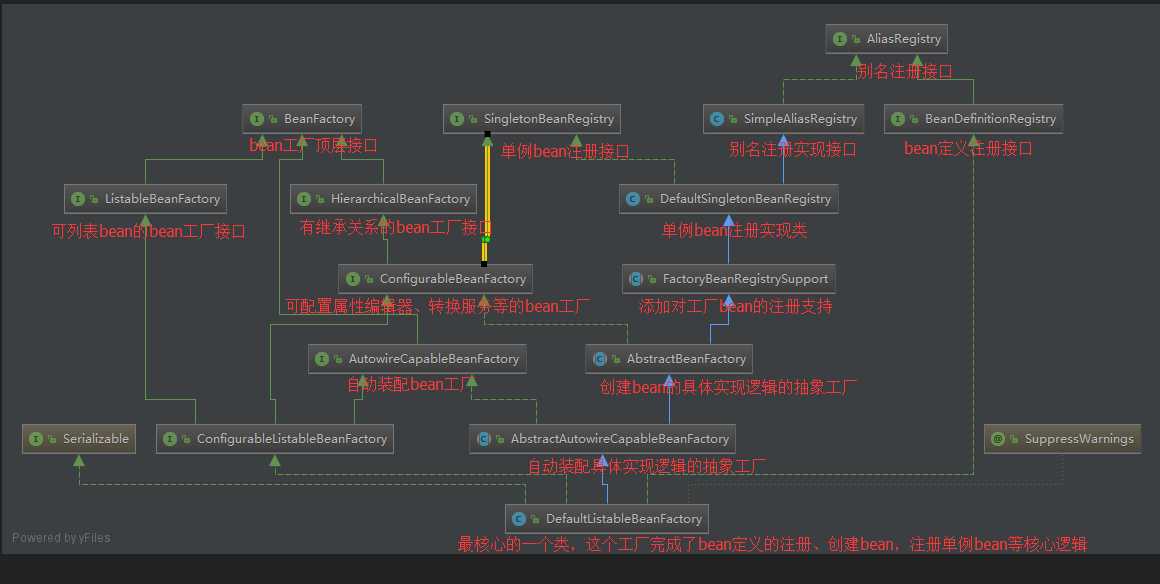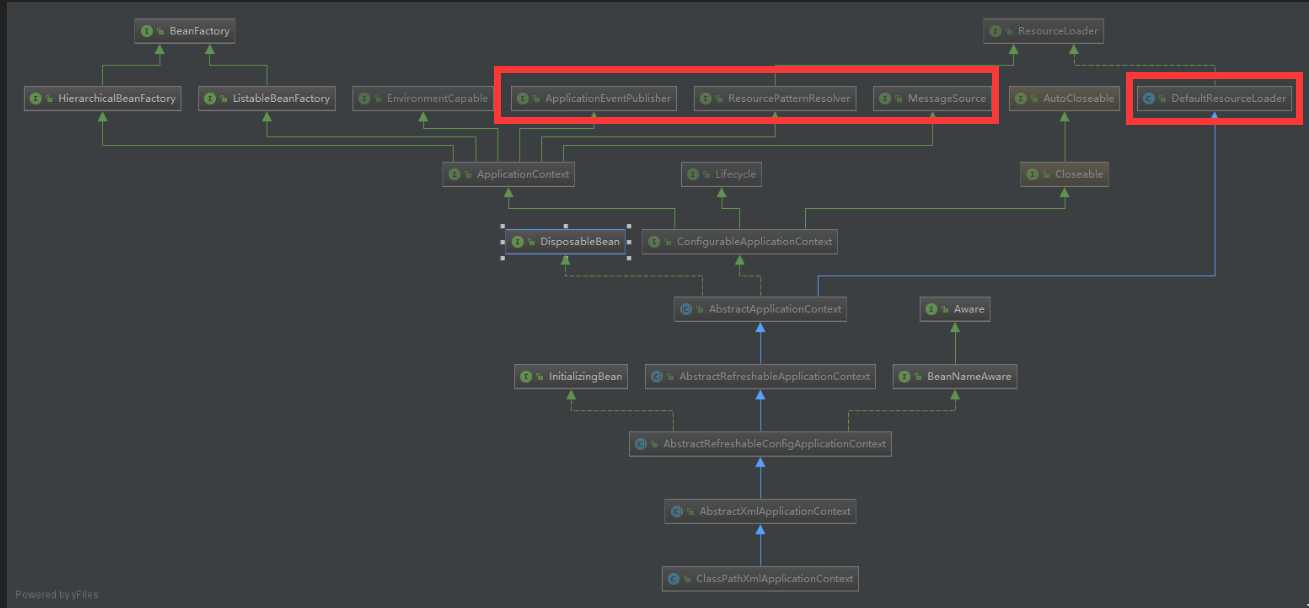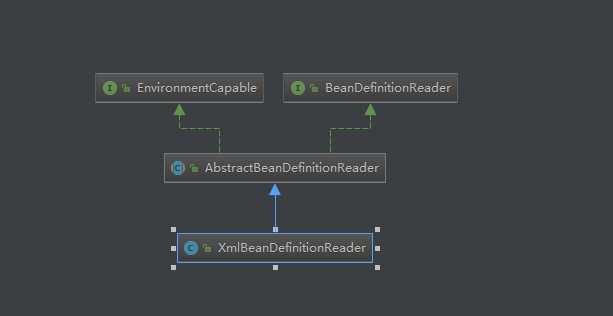标签:cte unique 依赖 scan final 元素 ceo config getenv
上一篇对启动时的整个流程进行了大体的分析,这一篇ioc的核心部分进行分析。包括初始化过程和依赖注入过程。
在分析之前先看几个类图

DefaultListableBeanFactory是ioc的一个核心类,可以看到我们关心的bean定义和单例bean都注册在它的属性上。

ClassPathXmlApplicationContext注意一下,它实现了事件发布、资源解析、消息源、资源加载的几个接口。
ClassPathXmlApplicationContext实现了资源加载接口,可以把xml配置的信息加载到Resource对象中。

XmlBeanDefinitionReader把Resouce中的内容读到Document对象中

DefaultBeanDefinitionDocumentReader负责把读取Document内容转化成BeanDefinition对象
//AbstractApplicationContext类的方法
//创建并返回DefaultListableBeanFactory
protected ConfigurableListableBeanFactory obtainFreshBeanFactory() { refreshBeanFactory(); ConfigurableListableBeanFactory beanFactory = getBeanFactory(); if (logger.isDebugEnabled()) { logger.debug("Bean factory for " + getDisplayName() + ": " + beanFactory); } return beanFactory; }
//AbstractRefreshableApplicationContext类的方法
protected final void refreshBeanFactory() throws BeansException { if (hasBeanFactory()) { destroyBeans(); closeBeanFactory(); } try { DefaultListableBeanFactory beanFactory = createBeanFactory(); beanFactory.setSerializationId(getId()); customizeBeanFactory(beanFactory); loadBeanDefinitions(beanFactory); synchronized (this.beanFactoryMonitor) { this.beanFactory = beanFactory; } } catch (IOException ex) { throw new ApplicationContextException("I/O error parsing bean definition source for " + getDisplayName(), ex); } }
//AbstractXmlApplicationContext类的方法
protected void loadBeanDefinitions(DefaultListableBeanFactory beanFactory) throws BeansException, IOException { // Create a new XmlBeanDefinitionReader for the given BeanFactory. XmlBeanDefinitionReader beanDefinitionReader = new XmlBeanDefinitionReader(beanFactory); // Configure the bean definition reader with this context‘s // resource loading environment. beanDefinitionReader.setEnvironment(this.getEnvironment()); beanDefinitionReader.setResourceLoader(this); beanDefinitionReader.setEntityResolver(new ResourceEntityResolver(this)); // Allow a subclass to provide custom initialization of the reader, // then proceed with actually loading the bean definitions. initBeanDefinitionReader(beanDefinitionReader); loadBeanDefinitions(beanDefinitionReader); }
//AbstractXmlApplicationContext类的方法
protected void loadBeanDefinitions(XmlBeanDefinitionReader reader) throws BeansException, IOException { Resource[] configResources = getConfigResources(); if (configResources != null) { reader.loadBeanDefinitions(configResources); } String[] configLocations = getConfigLocations(); if (configLocations != null) { reader.loadBeanDefinitions(configLocations); } }
//AbstractBeanDefinitionReader类的方法 public int loadBeanDefinitions(String... locations) throws BeanDefinitionStoreException { Assert.notNull(locations, "Location array must not be null"); int counter = 0; for (String location : locations) { counter += loadBeanDefinitions(location); } return counter; }
//AbstractBeanDefinitonReader类的方法 public int loadBeanDefinitions(String location) throws BeanDefinitionStoreException { return loadBeanDefinitions(location, null); }
//AbstractBeanDefinitionReader类的方法 public int loadBeanDefinitions(String location, Set<Resource> actualResources) throws BeanDefinitionStoreException { ResourceLoader resourceLoader = getResourceLoader(); if (resourceLoader == null) { throw new BeanDefinitionStoreException( "Cannot import bean definitions from location [" + location + "]: no ResourceLoader available"); } if (resourceLoader instanceof ResourcePatternResolver) { // Resource pattern matching available. try { Resource[] resources = ((ResourcePatternResolver) resourceLoader).getResources(location); int loadCount = loadBeanDefinitions(resources); if (actualResources != null) { for (Resource resource : resources) { actualResources.add(resource); } } if (logger.isDebugEnabled()) { logger.debug("Loaded " + loadCount + " bean definitions from location pattern [" + location + "]"); } return loadCount; } catch (IOException ex) { throw new BeanDefinitionStoreException( "Could not resolve bean definition resource pattern [" + location + "]", ex); } } else { // Can only load single resources by absolute URL. Resource resource = resourceLoader.getResource(location); int loadCount = loadBeanDefinitions(resource); if (actualResources != null) { actualResources.add(resource); } if (logger.isDebugEnabled()) { logger.debug("Loaded " + loadCount + " bean definitions from location [" + location + "]"); } return loadCount; } }
//AbstractBeanDefinitionReader类的方法
public int loadBeanDefinitions(Resource... resources) throws BeanDefinitionStoreException { Assert.notNull(resources, "Resource array must not be null"); int counter = 0; for (Resource resource : resources) { counter += loadBeanDefinitions(resource); } return counter; }
//XmlBeanDefinitionReader类的方法 public int loadBeanDefinitions(Resource resource) throws BeanDefinitionStoreException { return loadBeanDefinitions(new EncodedResource(resource)); }
//XmlBeanDefintionReader类的方法 public int loadBeanDefinitions(EncodedResource encodedResource) throws BeanDefinitionStoreException { Assert.notNull(encodedResource, "EncodedResource must not be null"); if (logger.isInfoEnabled()) { logger.info("Loading XML bean definitions from " + encodedResource.getResource()); } //使用ThreadLocal,实现随用随取 Set<EncodedResource> currentResources = this.resourcesCurrentlyBeingLoaded.get(); if (currentResources == null) { currentResources = new HashSet<EncodedResource>(4); this.resourcesCurrentlyBeingLoaded.set(currentResources); } //判断资源文件有没有重复载入 if (!currentResources.add(encodedResource)) { throw new BeanDefinitionStoreException( "Detected cyclic loading of " + encodedResource + " - check your import definitions!"); } try { InputStream inputStream = encodedResource.getResource().getInputStream(); try { InputSource inputSource = new InputSource(inputStream); if (encodedResource.getEncoding() != null) { inputSource.setEncoding(encodedResource.getEncoding()); } return doLoadBeanDefinitions(inputSource, encodedResource.getResource()); } finally { inputStream.close(); } } catch (IOException ex) { throw new BeanDefinitionStoreException( "IOException parsing XML document from " + encodedResource.getResource(), ex); } finally { currentResources.remove(encodedResource); if (currentResources.isEmpty()) { this.resourcesCurrentlyBeingLoaded.remove(); } } }
//XmlBeanDefinitionReader类的方法
protected int doLoadBeanDefinitions(InputSource inputSource, Resource resource) throws BeanDefinitionStoreException { try { Document doc = doLoadDocument(inputSource, resource); return registerBeanDefinitions(doc, resource); } catch (BeanDefinitionStoreException ex) { throw ex; } catch (SAXParseException ex) { throw new XmlBeanDefinitionStoreException(resource.getDescription(), "Line " + ex.getLineNumber() + " in XML document from " + resource + " is invalid", ex); } catch (SAXException ex) { throw new XmlBeanDefinitionStoreException(resource.getDescription(), "XML document from " + resource + " is invalid", ex); } catch (ParserConfigurationException ex) { throw new BeanDefinitionStoreException(resource.getDescription(), "Parser configuration exception parsing XML from " + resource, ex); } catch (IOException ex) { throw new BeanDefinitionStoreException(resource.getDescription(), "IOException parsing XML document from " + resource, ex); } catch (Throwable ex) { throw new BeanDefinitionStoreException(resource.getDescription(), "Unexpected exception parsing XML document from " + resource, ex); } }
public int registerBeanDefinitions(Document doc, Resource resource) throws BeanDefinitionStoreException {
BeanDefinitionDocumentReader documentReader = createBeanDefinitionDocumentReader();
int countBefore = getRegistry().getBeanDefinitionCount();
documentReader.registerBeanDefinitions(doc, createReaderContext(resource));
return getRegistry().getBeanDefinitionCount() - countBefore;
}
//DefaultBeanDefintionDocumentReader类的方法
public void registerBeanDefinitions(Document doc, XmlReaderContext readerContext) { this.readerContext = readerContext; logger.debug("Loading bean definitions"); Element root = doc.getDocumentElement(); doRegisterBeanDefinitions(root); } //DefaultBeanDefintionDocumentReader类的方法 protected void doRegisterBeanDefinitions(Element root) { BeanDefinitionParserDelegate parent = this.delegate; this.delegate = createDelegate(getReaderContext(), root, parent); if (this.delegate.isDefaultNamespace(root)) { String profileSpec = root.getAttribute(PROFILE_ATTRIBUTE); if (StringUtils.hasText(profileSpec)) { String[] specifiedProfiles = StringUtils.tokenizeToStringArray( profileSpec, BeanDefinitionParserDelegate.MULTI_VALUE_ATTRIBUTE_DELIMITERS); if (!getReaderContext().getEnvironment().acceptsProfiles(specifiedProfiles)) { if (logger.isInfoEnabled()) { logger.info("Skipped XML bean definition file due to specified profiles [" + profileSpec + "] not matching: " + getReaderContext().getResource()); } return; } } } preProcessXml(root); parseBeanDefinitions(root, this.delegate); postProcessXml(root); this.delegate = parent; }
//DefaultBeanDefintioinDocumentReader类的方法 protected void parseBeanDefinitions(Element root, BeanDefinitionParserDelegate delegate) { if (delegate.isDefaultNamespace(root)) { NodeList nl = root.getChildNodes(); for (int i = 0; i < nl.getLength(); i++) { Node node = nl.item(i); if (node instanceof Element) { Element ele = (Element) node; if (delegate.isDefaultNamespace(ele)) { parseDefaultElement(ele, delegate); } else { delegate.parseCustomElement(ele); } } } } else { delegate.parseCustomElement(root); } }
//DefaultBeanDefintionDocumentReader类的方法
private void parseDefaultElement(Element ele, BeanDefinitionParserDelegate delegate) {
if (delegate.nodeNameEquals(ele, IMPORT_ELEMENT)) {
importBeanDefinitionResource(ele);
}
else if (delegate.nodeNameEquals(ele, ALIAS_ELEMENT)) {
processAliasRegistration(ele);
}
else if (delegate.nodeNameEquals(ele, BEAN_ELEMENT)) {
processBeanDefinition(ele, delegate);
}
else if (delegate.nodeNameEquals(ele, NESTED_BEANS_ELEMENT)) {
// recurse
doRegisterBeanDefinitions(ele);
}
}
//DefaultBeanDefintionDocumentReader类的方法
protected void processBeanDefinition(Element ele, BeanDefinitionParserDelegate delegate) {
BeanDefinitionHolder bdHolder = delegate.parseBeanDefinitionElement(ele);
if (bdHolder != null) {
bdHolder = delegate.decorateBeanDefinitionIfRequired(ele, bdHolder);
try {
// Register the final decorated instance.
BeanDefinitionReaderUtils.registerBeanDefinition(bdHolder, getReaderContext().getRegistry());
}
catch (BeanDefinitionStoreException ex) {
getReaderContext().error("Failed to register bean definition with name ‘" +
bdHolder.getBeanName() + "‘", ele, ex);
}
// Send registration event.
getReaderContext().fireComponentRegistered(new BeanComponentDefinition(bdHolder));
}
}
BeanDefinitonHolder中有BeanDefiniton、beanName以及bean的别名数组。
public BeanDefinitionHolder parseBeanDefinitionElement(Element ele) {
return parseBeanDefinitionElement(ele, null);
}
public BeanDefinitionHolder parseBeanDefinitionElement(Element ele, BeanDefinition containingBean) {
String id = ele.getAttribute(ID_ATTRIBUTE);
String nameAttr = ele.getAttribute(NAME_ATTRIBUTE);
List<String> aliases = new ArrayList<String>();
if (StringUtils.hasLength(nameAttr)) {
String[] nameArr = StringUtils.tokenizeToStringArray(nameAttr, MULTI_VALUE_ATTRIBUTE_DELIMITERS);
aliases.addAll(Arrays.asList(nameArr));
}
String beanName = id;
if (!StringUtils.hasText(beanName) && !aliases.isEmpty()) {
beanName = aliases.remove(0);
if (logger.isDebugEnabled()) {
logger.debug("No XML ‘id‘ specified - using ‘" + beanName +
"‘ as bean name and " + aliases + " as aliases");
}
}
if (containingBean == null) {
checkNameUniqueness(beanName, aliases, ele);
}
AbstractBeanDefinition beanDefinition = parseBeanDefinitionElement(ele, beanName, containingBean);
if (beanDefinition != null) {
if (!StringUtils.hasText(beanName)) {
try {
if (containingBean != null) {
beanName = BeanDefinitionReaderUtils.generateBeanName(
beanDefinition, this.readerContext.getRegistry(), true);
}
else {
beanName = this.readerContext.generateBeanName(beanDefinition);
// Register an alias for the plain bean class name, if still possible,
// if the generator returned the class name plus a suffix.
// This is expected for Spring 1.2/2.0 backwards compatibility.
String beanClassName = beanDefinition.getBeanClassName();
if (beanClassName != null &&
beanName.startsWith(beanClassName) && beanName.length() > beanClassName.length() &&
!this.readerContext.getRegistry().isBeanNameInUse(beanClassName)) {
aliases.add(beanClassName);
}
}
if (logger.isDebugEnabled()) {
logger.debug("Neither XML ‘id‘ nor ‘name‘ specified - " +
"using generated bean name [" + beanName + "]");
}
}
catch (Exception ex) {
error(ex.getMessage(), ele);
return null;
}
}
String[] aliasesArray = StringUtils.toStringArray(aliases);
return new BeanDefinitionHolder(beanDefinition, beanName, aliasesArray);
}
return null;
}
public AbstractBeanDefinition parseBeanDefinitionElement(
Element ele, String beanName, BeanDefinition containingBean) {
this.parseState.push(new BeanEntry(beanName));
String className = null;
if (ele.hasAttribute(CLASS_ATTRIBUTE)) {
className = ele.getAttribute(CLASS_ATTRIBUTE).trim();
}
try {
String parent = null;
if (ele.hasAttribute(PARENT_ATTRIBUTE)) {
parent = ele.getAttribute(PARENT_ATTRIBUTE);
}
AbstractBeanDefinition bd = createBeanDefinition(className, parent);
parseBeanDefinitionAttributes(ele, beanName, containingBean, bd);
bd.setDescription(DomUtils.getChildElementValueByTagName(ele, DESCRIPTION_ELEMENT));
parseMetaElements(ele, bd);
parseLookupOverrideSubElements(ele, bd.getMethodOverrides());
parseReplacedMethodSubElements(ele, bd.getMethodOverrides());
parseConstructorArgElements(ele, bd);
parsePropertyElements(ele, bd);
parseQualifierElements(ele, bd);
bd.setResource(this.readerContext.getResource());
bd.setSource(extractSource(ele));
return bd;
}
catch (ClassNotFoundException ex) {
error("Bean class [" + className + "] not found", ele, ex);
}
catch (NoClassDefFoundError err) {
error("Class that bean class [" + className + "] depends on not found", ele, err);
}
catch (Throwable ex) {
error("Unexpected failure during bean definition parsing", ele, ex);
}
finally {
this.parseState.pop();
}
return null;
}
public void parsePropertyElements(Element beanEle, BeanDefinition bd) {
NodeList nl = beanEle.getChildNodes();
for (int i = 0; i < nl.getLength(); i++) {
Node node = nl.item(i);
if (isCandidateElement(node) && nodeNameEquals(node, PROPERTY_ELEMENT)) {
parsePropertyElement((Element) node, bd);
}
}
}
public void parsePropertyElement(Element ele, BeanDefinition bd) {
String propertyName = ele.getAttribute(NAME_ATTRIBUTE);
if (!StringUtils.hasLength(propertyName)) {
error("Tag ‘property‘ must have a ‘name‘ attribute", ele);
return;
}
this.parseState.push(new PropertyEntry(propertyName));
try {
if (bd.getPropertyValues().contains(propertyName)) {
error("Multiple ‘property‘ definitions for property ‘" + propertyName + "‘", ele);
return;
}
Object val = parsePropertyValue(ele, bd, propertyName);
PropertyValue pv = new PropertyValue(propertyName, val);
parseMetaElements(ele, pv);
pv.setSource(extractSource(ele));
bd.getPropertyValues().addPropertyValue(pv);
}
finally {
this.parseState.pop();
}
}
public Object parsePropertyValue(Element ele, BeanDefinition bd, String propertyName) {
String elementName = (propertyName != null) ?
"<property> element for property ‘" + propertyName + "‘" :
"<constructor-arg> element";
// Should only have one child element: ref, value, list, etc.
NodeList nl = ele.getChildNodes();
Element subElement = null;
for (int i = 0; i < nl.getLength(); i++) {
Node node = nl.item(i);
if (node instanceof Element && !nodeNameEquals(node, DESCRIPTION_ELEMENT) &&
!nodeNameEquals(node, META_ELEMENT)) {
// Child element is what we‘re looking for.
if (subElement != null) {
error(elementName + " must not contain more than one sub-element", ele);
}
else {
subElement = (Element) node;
}
}
}
boolean hasRefAttribute = ele.hasAttribute(REF_ATTRIBUTE);
boolean hasValueAttribute = ele.hasAttribute(VALUE_ATTRIBUTE);
if ((hasRefAttribute && hasValueAttribute) ||
((hasRefAttribute || hasValueAttribute) && subElement != null)) {
error(elementName +
" is only allowed to contain either ‘ref‘ attribute OR ‘value‘ attribute OR sub-element", ele);
}
if (hasRefAttribute) {
String refName = ele.getAttribute(REF_ATTRIBUTE);
if (!StringUtils.hasText(refName)) {
error(elementName + " contains empty ‘ref‘ attribute", ele);
}
RuntimeBeanReference ref = new RuntimeBeanReference(refName);
ref.setSource(extractSource(ele));
return ref;
}
else if (hasValueAttribute) {
TypedStringValue valueHolder = new TypedStringValue(ele.getAttribute(VALUE_ATTRIBUTE));
valueHolder.setSource(extractSource(ele));
return valueHolder;
}
else if (subElement != null) {
return parsePropertySubElement(subElement, bd);
}
else {
// Neither child element nor "ref" or "value" attribute found.
error(elementName + " must specify a ref or value", ele);
return null;
}
}
public Object parsePropertySubElement(Element ele, BeanDefinition bd) {
return parsePropertySubElement(ele, bd, null);
}
public Object parsePropertySubElement(Element ele, BeanDefinition bd, String defaultValueType) {
if (!isDefaultNamespace(ele)) {
return parseNestedCustomElement(ele, bd);
}
else if (nodeNameEquals(ele, BEAN_ELEMENT)) {
BeanDefinitionHolder nestedBd = parseBeanDefinitionElement(ele, bd);
if (nestedBd != null) {
nestedBd = decorateBeanDefinitionIfRequired(ele, nestedBd, bd);
}
return nestedBd;
}
else if (nodeNameEquals(ele, REF_ELEMENT)) {
// A generic reference to any name of any bean.
String refName = ele.getAttribute(BEAN_REF_ATTRIBUTE);
boolean toParent = false;
if (!StringUtils.hasLength(refName)) {
// A reference to the id of another bean in the same XML file.
refName = ele.getAttribute(LOCAL_REF_ATTRIBUTE);
if (!StringUtils.hasLength(refName)) {
// A reference to the id of another bean in a parent context.
refName = ele.getAttribute(PARENT_REF_ATTRIBUTE);
toParent = true;
if (!StringUtils.hasLength(refName)) {
error("‘bean‘, ‘local‘ or ‘parent‘ is required for <ref> element", ele);
return null;
}
}
}
if (!StringUtils.hasText(refName)) {
error("<ref> element contains empty target attribute", ele);
return null;
}
RuntimeBeanReference ref = new RuntimeBeanReference(refName, toParent);
ref.setSource(extractSource(ele));
return ref;
}
else if (nodeNameEquals(ele, IDREF_ELEMENT)) {
return parseIdRefElement(ele);
}
else if (nodeNameEquals(ele, VALUE_ELEMENT)) {
return parseValueElement(ele, defaultValueType);
}
else if (nodeNameEquals(ele, NULL_ELEMENT)) {
// It‘s a distinguished null value. Let‘s wrap it in a TypedStringValue
// object in order to preserve the source location.
TypedStringValue nullHolder = new TypedStringValue(null);
nullHolder.setSource(extractSource(ele));
return nullHolder;
}
else if (nodeNameEquals(ele, ARRAY_ELEMENT)) {
return parseArrayElement(ele, bd);
}
else if (nodeNameEquals(ele, LIST_ELEMENT)) {
return parseListElement(ele, bd);
}
else if (nodeNameEquals(ele, SET_ELEMENT)) {
return parseSetElement(ele, bd);
}
else if (nodeNameEquals(ele, MAP_ELEMENT)) {
return parseMapElement(ele, bd);
}
else if (nodeNameEquals(ele, PROPS_ELEMENT)) {
return parsePropsElement(ele);
}
else {
error("Unknown property sub-element: [" + ele.getNodeName() + "]", ele);
return null;
}
}
//BeanDefinitonReaderUtils
public static void registerBeanDefinition(
BeanDefinitionHolder definitionHolder, BeanDefinitionRegistry registry)
throws BeanDefinitionStoreException {
// Register bean definition under primary name.
String beanName = definitionHolder.getBeanName();
registry.registerBeanDefinition(beanName, definitionHolder.getBeanDefinition());
// Register aliases for bean name, if any.
String[] aliases = definitionHolder.getAliases();
if (aliases != null) {
for (String alias : aliases) {
registry.registerAlias(beanName, alias);
}
}
}
整个过程可以分为:
https://www.cnblogs.com/niejunlei/archive/2016/11/11/6054713.html(prepareBeanFactory)
https://www.cnblogs.com/wade-luffy/p/6074088.html(生命周期后置处理器)
https://blog.csdn.net/zhangduilei/article/details/76172355(注册JMX)
标签:cte unique 依赖 scan final 元素 ceo config getenv
原文地址:https://www.cnblogs.com/lucas2/p/9501555.html